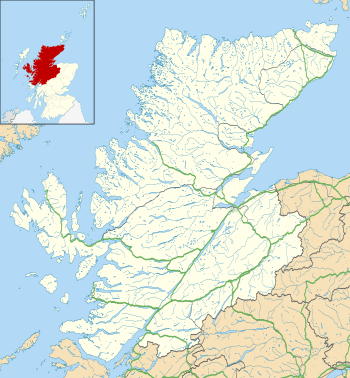Wick Airport
Wick John O' Groats Airport (IATA: WIC, ICAO: EGPC) is located 1 nautical mile (1.9 km; 1.2 mi) north of the town of Wick, at the north-eastern extremity of the mainland of Scotland. It is owned and maintained by Highlands and Islands Airports Limited. The airport used to provided commercial air travel connections for Caithness, with scheduled services to Aberdeen Airport and Edinburgh Airport. It remains regularly used by helicopters servicing local offshore oil operations and the Beatrice Offshore Windfarm. It also serves as a stop-over for light aircraft ferry flights between Europe and North America via Iceland.
Wick John O' Groats Airport | |||||||||||
|---|---|---|---|---|---|---|---|---|---|---|---|
 | |||||||||||
| Summary | |||||||||||
| Airport type | Public | ||||||||||
| Owner/Operator | Highlands and Islands Airports Limited | ||||||||||
| Serves | Wick, Caithness | ||||||||||
| Location | Wick, Scotland, UK | ||||||||||
| Elevation AMSL | 126 ft / 38 m | ||||||||||
| Coordinates | 58°27′32″N 003°05′35″W | ||||||||||
| Website | hial.co.uk | ||||||||||
| Map | |||||||||||
 EGPC Location in Highland | |||||||||||
| Runways | |||||||||||
| |||||||||||
| Statistics (2019) | |||||||||||
| |||||||||||
History
Wick was originally a grass airfield, used by Captain E. E. Fresson's Highland Airways Ltd. (later Scottish Airways Ltd.) from 1933 until 1939.
Requisitioned by the Air Ministry during World War II, the airfield was extended with hard runways, hangars, and other buildings. The airfield was administered by No. 18 Group, RAF Coastal Command. A satellite airfield existed at RAF Skitten.
On 21 May 1941, a photographic reconnaissance Supermarine Spitfire piloted by Flying Officer Michael F. Suckling took off from Wick, and flew to Norway, in search of the German battleship Bismarck. If Bismarck was to break out into the North Atlantic, she would present a significant risk to the ships supplying Britain. 320 miles to the east of Wick, F/O Suckling found and photographed her, hiding in Grimstadfjord.[3] This information enabled the Royal Navy to order HMS Hood and other ships, as well as aircraft, to take positions intended to track Bismarck, and prevent her from entering the North Atlantic. In ensuing battles, Hood was sunk, and, later, Bismarck.
German battleships and battle cruisers never again entered the North Atlantic, partly because of continual reconnaissance flights by the RAF of German naval activity. Many of these flights originated at Wick. On 5 March 1942, RAF reconnaissance pilot Sandy Gunn (a native of Auchterarder, Perthshire), was shot down in his Spitfire on a flight from Wick over German naval installations in Norway. He survived and became a prisoner of war, but two years later he was executed after participating in the "Great Escape" from Stalag Luft III.
Airlines and destinations
LoganAir operated regular flights from Wick between 1976 and 2020, with the final flight to Edinburgh departing on 27 March 2020.[4] On 19 June 2020, Eastern Airways removed Wick from its network, leaving the airport with no scheduled services.[5]
Statistics
| Rank | Airport | Passengers handled | 2018-19 Change |
|---|---|---|---|
| 1 | 7,395 | ||
| 2 | 5,317 |
| Rank | Airport | Passengers handled | 2017-2018 change |
|---|---|---|---|
| 1 | 9,341 | ||
| 2 | 7,775 | ||
References
- "NATS | AIS - Home".
- "Airport data 2017 | UK Civil Aviation Authority". www.caa.co.uk.
- Conyers, Roy (2003). Eyes of the RAF. Sutton Publishing. p. 118. ISBN 0750932562.
- Hendry, Alan (17 March 2020). "Loganair to axe Wick to Edinburgh service". John O'Groat Journal. Retrieved 29 July 2020.
- MacLennan, Chris (26 June 2020). "Demand for answers on future of Wick Airport following withdrawal of commercial services". The Press and Journal. Retrieved 29 June 2020.
- "Domestic Air Passenger Traffic To and From Reporting Airports for 2019, comparison with 2018" (PDF). Civil Aviation Authority. Retrieved 19 June 2020.
- Halley, James J. The Squadrons of the Royal Air Force. Tonbridge, Kent: Air-Britain (Historians) Ltd, 1980. ISBN 0-85130-083-9.
External links
![]()
- Map sources for Wick Airport
- Facebook page